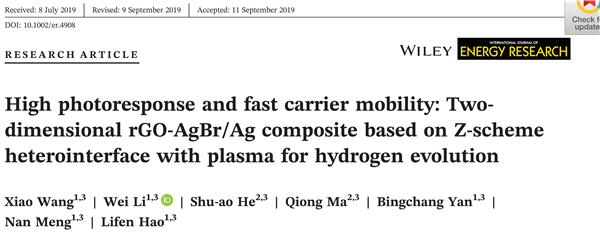High photoresponse and fast carrier mobility: Two-dimensional rGO-AgBr/Ag composite based on Z-scheme heterointerface with plasma for hydrogen evolution
作者:X. Wang, W. Li, S. He, Q. Ma, B. Yan, N. Meng, L. Hao
关键字:AgBr, Ag plasma, heterostructure, hydrogen evolution, reduced graphene oxide
论文来源:期刊
具体来源:https://onlinelibrary.wiley.com/doi/abs/10.1002/er.4908
发表时间:2019年

With the improvement of people's living standard, energy shortage is increasingly severe. Photocatalysis technology is one of the most effective means to solve this problem. Generally, poor visible‐light response and fast combination of photo‐induced carriers are the main limiting factors to traditional photocatalysts. Aiming at this problem, in this paper, AgBr was used as the photosensitizer to immobilize on the surface of reduced graphene oxide (rGO) for the complexation of Ag+ ions and carboxyl groups of precursor graphene oxide (GO), then the two‐dimensional rGO‐AgBr/Ag composites (2D rGAA‐α, α = 1, 2 and 3) were synthesized by solvothermal method. The structures, morphologies, chemical bonding states and photoelectrochemical properties of the samples were analyzed to study the samples, and the corresponding visible‐light‐driven (VLD) catalytic performances were studied by hydrogen evolution reaction (HER). Compared with pure rGO, the light absorption of rGAA‐α was almost extended to full spectral range for the Z‐scheme heterointerface (rGO‐AgBr) construction, and the separation of photo‐induced carriers can be promoted effectively. The HER results showed that the average hydrogen evolution rate ( Rp) of rGAA‐α was significantly increased, and the rGAA‐2 catalyst presented the highest Rp (72.71 μmol h‐1g‐1). After six recycling experiments, the very faint activity decrease and unobvious structure change suggested the high photostability. Accordingly, the enhanced catalytic activity of rGAA‐α catalysts was attributed to the formation of Z‐scheme heterointerface and generation of Ag plasmas, so this study will provide a simple, effective and promising method for hydrogen energy development.
Int J Energy Res. 2019;1–12